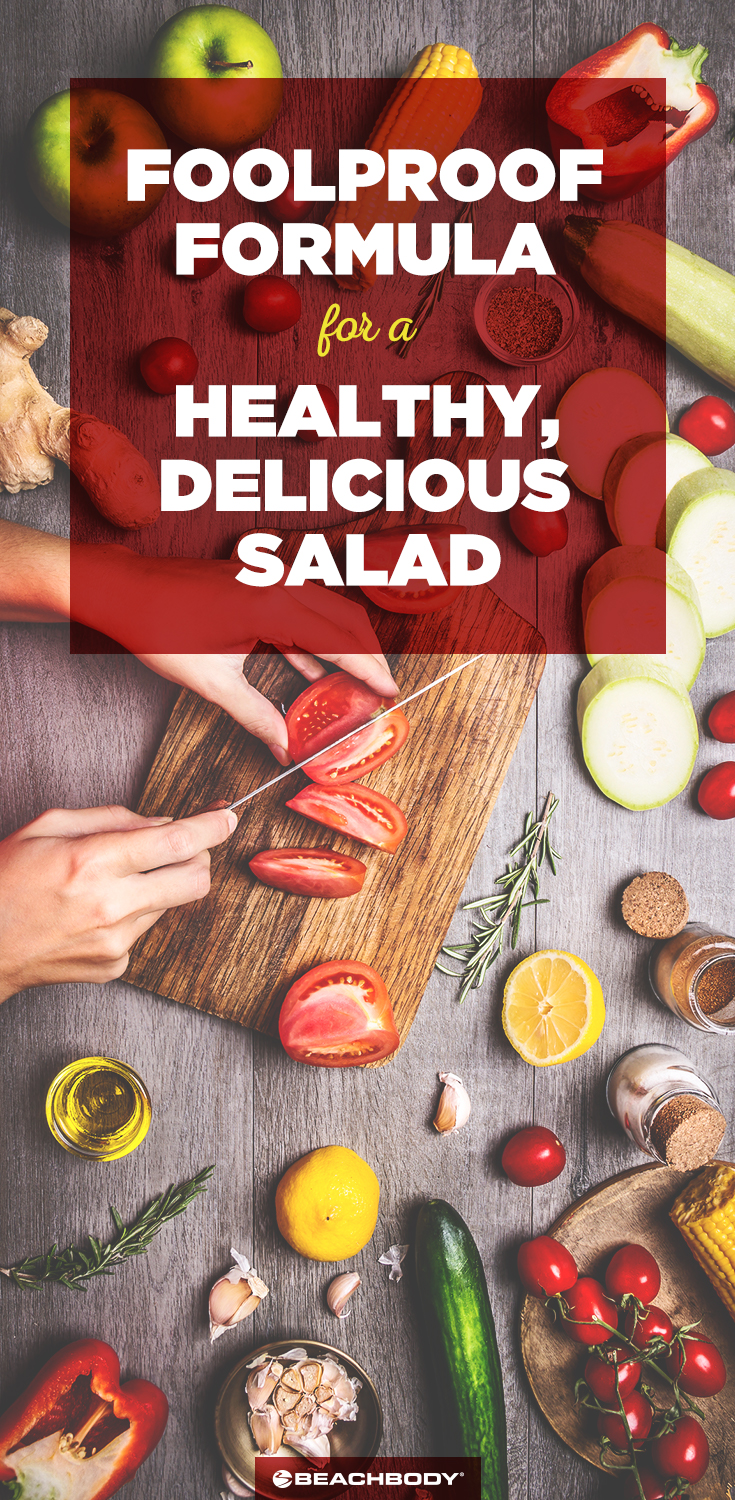Foolproof Formula for a Healthy, Delicious Salad
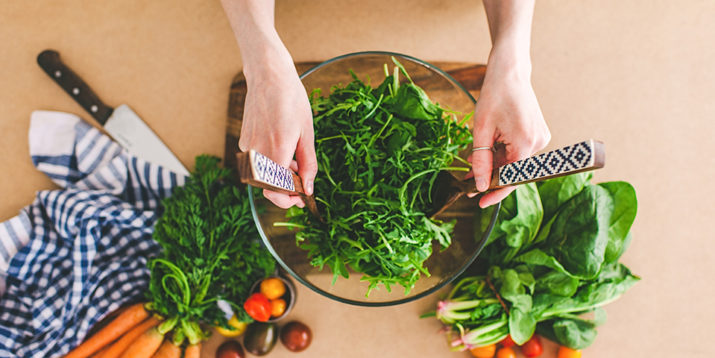
If you’re struggling to eat enough fruits and vegetables, salads are an easy, tasty way to reach your daily quota, or at least get yourself a lot closer!
They can also be a nutrient-dense, filling meal on their own when you know what to include.
But beware: Salads can easily turn into calorie bombs if you’re not keeping an eye on portions and ingredients.
To simplify your salad-making process, we came up with a foolproof formula for a filling and healthy salad.
But first, let’s take a look at where your bowl of greens may be going astray.
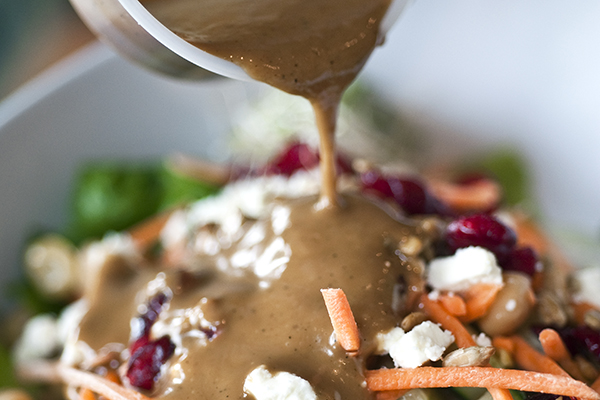
The 4 Biggest Salad Mistakes (and How to Fix Them)
Mistake: You limit your salad to vegetables
“The more veggies you add, the more filling it will be,” says Chelsey Amer, a registered dietitian based in New York City.
She loves to bulk up salads with other nutrient-dense veggies like broccoli, cabbage, cucumbers, and tomatoes.
But if you’re making your salad a meal rather than a side, go beyond those non-starchy vegetables, says Alyssa Cohen M.S., R.D., L.D.N.
“While non-starchy vegetables are an important dietary component, [your salad] will lack protein and fat, which are also important components of any meal, ” she cautions.
Ideally, your salad should include all three macronutrients — carbs, protein, and fat.
Mistake: You overdo it — or skimp — on the dressing
“Dressing is meant to be a fat source,” says Cohen, which will add satiety and mouthfeel to your salad, “but it’s common for people to douse their salads.”
Not only does drowning your greens add extra fat and significant calories, but in the case of bottled dressings, you may also be adding sugar, salt, and other additives.
But don’t feel compelled to skip the dressing — that’s no fun, and you need fat to absorb certain essential nutrients.
“Let it enhance your salad rather than overwhelm it,” says Cohen.
It’s easy to make your own delicious dressing at home — where you control the ingredients.
We recommend one to two tablespoons of dressing per salad. (More on homemade dressings below!)

Mistake: You load up on high-calorie toppings
Fat is the most calorically dense macronutrient — nine calories per gram — so it can be easy to overdo it.
If you’re making a salad at home or ordering from a menu, think “some” not “all” when you’re deciding which toppings and fat sources to include.
Avocado, nuts, seeds, and cheese are all tasty toppings, but “while many of these sources are not inherently unhealthy on their own, the combination of these fat sources can add up to a lot of calories very quickly,” says Cohen.
She recommends keeping portions of these add-ins small and choosing one or two of your favorites, instead of all of them.
Mistake: Your salad is full of sugar
Sugar is a sneaky ingredient, and it can hide in even savory salads in the form of dried fruit, candied nuts and seeds, fried or caramelized “crunchy” items, and of course, salad dressings, says Cohen.
“If you prefer some sweetness, opt for fresh fruit,” she advises. If you do include those other items on a salad, use them as a garnish, not as a significant part of your salad.

How to Build the Perfect Salad
Ready to make the best salad ever? Here’s our formula to help you build the perfect salad, from greens to dressing, and everything in between.
Step 1: Build Your Base
Grab your greens. Instead of just a bowl of iceberg, try combinations of leafy greens: butter, romaine, arugula, endive, escarole, radicchio, chard, spinach, and mesclun.
Choose a mix of soft and crunchy, as well as sweet and bitter greens. If you’re new to eating greens or still learning to like vegetables, shredding or finely chopping the leaves can make them more palatable.
Worried about the cost and potential waste of buying several types of greens? Grab a premixed blend from the store.
Pro tip: If you’re using a hearty green like kale or cabbage, massage the leaves with a pinch of salt and a drizzle of lemon juice or vinegar ahead of serving time. This will soften greens and make them easier to chew.
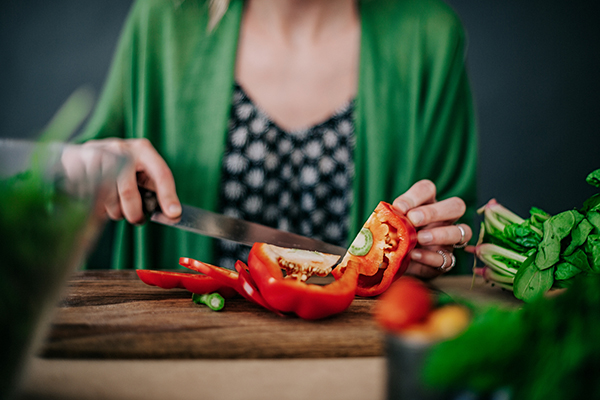
Step 2: Fill Up With More Vegetables — and Fruit
Once you have your bowl of greens, reach for fruits and non-starchy vegetables. Now’s your chance to eat the colors of the rainbow, and don’t forget the “pale” veggies, too.
Try asparagus, radishes, sprouts, jicama, broccoli, bell peppers, or onions. Loading up on non-starchy vegetables can help you feel more satisfied while eating fewer calories.
Think about mixing a variety of colors, textures, and flavors.
Or create a theme, like a taco salad, Salad Niçoise, or a homemade version of your favorite takeout salad.
And if you’re not keen on raw vegetables, add in grilled, steamed, or roasted vegetables, warm or cold.
Then add some fruit. “I love to add some fruit to my salad for a sweet surprise hidden among the greens,” says Amer.
Tasty options include apples, pears, berries, citrus, or melon.
Pro tip: Make a semi-homemade salad by buying bags or containers of greens, then picking up a few prepared vegetables from the salad bar — shredded beets and carrots, diced peppers, riced cauliflower, or roasted squash.
Step 3: Pick a Protein
Give all those veggies some staying power with a serving of lean protein.
Though Amer loves tuna salad and grilled salmon, she also enjoys getting creative with proteins: One of her recent discoveries was a small amount of smoked salmon and a poached egg on an arugula salad for breakfast. The runny yolk creates a warm, savory dressing.
Cottage cheese or tofu can be a protein source, as can eggs and fish. “And of course, grilled or baked chicken/turkey, a lean steak, or fish/shellfish are great options for meat-eaters,” says Cohen.
Keep prep time to a minimum by keeping cooked proteins on hand for your salads.
Bake or grill tofu, salmon, or chicken ahead of time; drain and rinse beans, and boil and peel some eggs so you can have a meal in minutes.
If you’re using leftover meats, thinly slice them to spread the flavor throughout your salad.
Step 4: Choose Your Carbs
Crackers and croutons are the typical carb companions for a salad, but they often add unwanted fat and salt (and sometimes trans fats).
To add healthy carbs to your salad, think leftovers. Cohen tops her salads with healthy carbs like roasted squash. This also helps winterize your salads by giving them some heft and warmth.
Quinoa, farro, beans, or lentils make great carb choices because they also contain protein.
You can also try these healthier cracker and chip swaps, or add a small amount of store-bought ones — Cohen likes to crumble a few tortilla chips made from beans over her taco salads.
If you’re a crouton fan, try making your own to control how much oil is used, or grill a slice of whole-grain bread for a healthier Caesar salad.
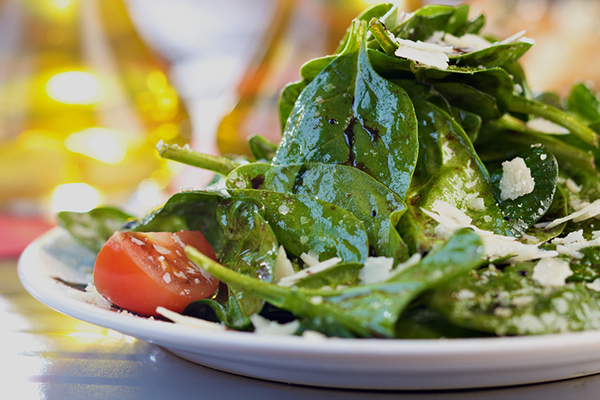
Step 5: Add Healthy Fats
Fat adds flavor and satisfaction, but it also pours on the calories quickly. While the healthy fat in salads usually comes from dressing, you can use avocado, nuts, and seeds.
Cohen likes to make her own dressing using ingredients such as avocado, olive oil, and red wine vinegar, sometimes adding mustard or lemon juice for extra flavor.
Bottled dressings have come a long way, she says, and many contain only whole-food ingredients. “Just remember — no matter how great the ingredients label may look, keeping portions in check is key,” she adds.
Amer recommends using a dressing that’s translucent or mostly translucent, such as a vinaigrette.
At home, she uses a 1:1 ratio of vinegar to oil to boost flavor and keep healthy fats in check. Adding a small amount of Dijon mustard to this mix will act as a binder.
“Always underdress your salad to start,” Amer says since you can add more if need be.
If you want to use fat on top of your salad, in the form of nuts, avocado, or seeds, consider using salsa, a flavored vinegar, or lemon or lime juice as your “dressing,” omitting the oil.
Pro tip: Measure your dressing into a bowl, add the greens, and toss to coat every leaf. This is a restaurant trick that will help you stretch your dressing and add flavor to each bite.
Check out these delicious dressing recipes:
Step 6: Finish With Toppings and Flavor Boosts
The toppings are where you can take your salad from ho-hum to awesome, but it’s also an easy place to go overboard. (Hello, bacon bits!)
Amer adds flavor for almost no calories with fresh and dried herbs and spices. She loves all the health benefits she gets from adding cilantro, dill, parsley, and basil to her salads.
If you opt to use your fat as a topping, measure out your portion to avoid adding more than you intended.
Chop nuts and avocado into small pieces to stretch their flavor, and choose raw over roasted and salted nuts to avoid excess sodium.
The Bottom Line
Salads are an easy and delicious way to load up on all your food groups in one meal, but it’s important to remember to keep your portion sizes in control.
With this formula, you can mix and match and experiment to create a meal that’s delicious and healthy.
